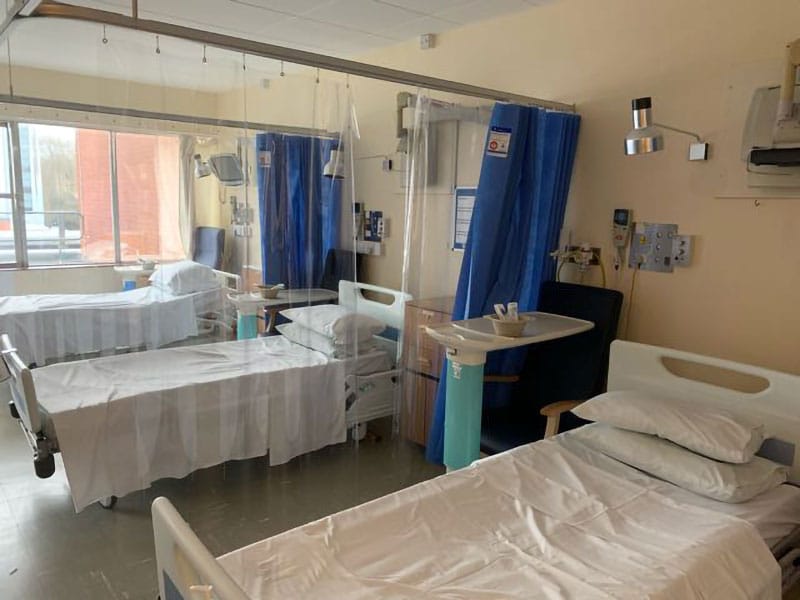What are the issues and risks when removing asbestos from hospitals?
A generation has now passed since it was last legally permissible for asbestos to be used in hospital buildings in the UK. A complete ban on all forms of asbestos in the UK has been in place since 1999 – although sadly, asbestos used prior to that time remains present in many hospital buildings up and down the country. This, in turn, raises the question of what risks such asbestos could still pose.
Indeed, as recently as early 2023, a study by the Labour Research Department (LRD) for the Trades Union Congress (TUC) and the All-Party Parliamentary Group on Occupational Safety and Health, found that two thirds of hospitals in London and Scotland still contained asbestos.
This tallies strongly with research from earlier years, indicating that asbestos continues to be present to a great degree across the UK’s hospital estates. A Freedom of Information request sent to all 243 of Britain’s NHS trusts in 2018, for example, found that of the 211 trusts responding, 198 stated that asbestos-containing materials (ACMs) were still present in their buildings. This equated to well over 90% of respondents.
With asbestos still being so widespread in the UK’s hospitals, then, it could scarcely be more important to ensure the right arrangements are in place for safely managing and/or removing the material.
The inhalation or ingestion of asbestos, after all, is associated with the potential development of frequently fatal health conditions, such as mesothelioma or asbestos-related lung cancer.
Understanding asbestos in hospitals
For much of the 20th century, asbestos was seen as something of a “wonder material” in construction, which helps to explain why it was used so widely – even for building hospitals.
From around the 1950s until the mid-1980s, a time when awareness of the health dangers of asbestos was only just gradually building among the general public, the naturally occurring mineral was particularly extensively used. This was due to factors ranging from its relative affordability and attainability to its strength and fire resistance.
As a consequence of such far-reaching use, to this day, asbestos can be found in various parts of hospital buildings that were constructed prior to the year 2000. This includes on steelwork and concrete, where it was applied as sprayed insulating coating, as well as in such forms as lagging on pipes and boilers, and insulation board in walls. The material was also used for the likes of ceiling tiles and flooring, where it may remain present in some healthcare facilities.
The knowledge of the sustained presence of asbestos across hospital buildings raises the question of whether enough is being done to manage it responsibly and safely, especially at a time when NHS budgets are under as much strain as ever.
ACMs can be susceptible to deteriorating over time, which in turn, can lead to a change in the nature of the risk they may pose. When this factor is combined with any accidental disturbance caused to the material, it is clear that the risks might be greater than many people may realise.
Risks and challenges in asbestos removal from hospitals
The task of managing asbestos in healthcare buildings can be a very complex and multifaceted one. This applies just as strongly where the decision has been made to remove certain asbestos from the premises altogether, instead of leaving it in place and managing it.
The below are all potential sources of risk and concern:
Health and safety concerns
It is, by now, well-established that breathing in or ingesting asbestos can lead to the development of various serious and potentially fatal health conditions. Exposure to asbestos has been linked to such diseases as mesothelioma, asbestos-related lung cancer, and asbestosis.
It might seem especially ironic and cruel for anyone to come into contact with asbestos – and potentially see the risk to their health elevated – in a setting that is meant to support good health.
And yet, hospital patients – as well as hospital staff and visitors – can indeed be vulnerable in situations where ACMs are disturbed or are in the process of being removed. So, it is of critical importance that responsible measures are followed, including the use of suitably qualified professionals for the actual asbestos removal work.
Disruption to hospital operations
Another source of challenge with regard to the removal of asbestos from hospital buildings, is the fact that these buildings tend to be actively used ones, catering to many of the most vulnerable people in the UK from a health perspective.
At a time when healthcare amenities seem to be under as much pressure as they have ever been, a given hospital might barely be able to afford arranging for certain wards or clinical services to be closed, in order to allow for asbestos removal works to take place.
This may necessitate a certain level of inventiveness and resourcefulness in how asbestos is removed in active healthcare environments. Whatever measures are put in place – for example, the introduction of alternative access/egress points to allow for asbestos to be removed from a particular location – there must always be a strong emphasis on minimising disruption to daily operations and patient care.
Regulatory compliance
In the UK, various stringent regulations and guidelines are in place to help keep hospital workers, patients, and visitors safe when asbestos is being removed from such healthcare facilities.
Some of the key regulations and guideline documents that apply to the process of removing asbestos from healthcare settings, are detailed below:
- The Control of Asbestos Regulations 2012: Also known as “CAR 2012”, these regulations provide a comprehensive framework for the management of asbestos in workplaces, including healthcare facilities. They outline the role of the “dutyholder”, including the dutyholder’s responsibilities and requirements in relation to asbestos surveys, risk assessments, removal, and disposal.
- The Health and Safety at Work etc. Act 1974: This is broader, overarching legislation that puts in place a general duty for employers and dutyholders to ensure the health, safety, and welfare of employees and others who may be impacted by work activities. You will need to bear this legislation in mind when coordinating the management and/or removal of asbestos from your healthcare premises.
- The Health and Safety Executive (HSE) Approved Code of Practice (ACoP) L143: If you are unsure how the responsibilities set out under CAR 2012 translate into necessary practical action, you should be consulting this guidance document. It provides detailed advice on the management of asbestos in non-domestic premises such as healthcare buildings.
- HSE Guidance HSG247: “Asbestos: The Licensed Contractors’ Guide”: As its title suggests, this document is aimed specifically at licensed asbestos removal contractors. Its information and advice covers the control of asbestos during removal work, including relevant requirements and good practice in healthcare settings.
- HSE Guidance HSG248: “Asbestos: The Analysts’ Guide for Sampling, Analysis, and Clearance Procedures”: This is another specialised document, written in order to assist analysts involved in asbestos sampling, analysis, and clearance procedures. It sets out specific guidance on assessing and monitoring asbestos removal in healthcare facilities.
- The Construction (Design and Management) Regulations 2015 (CDM Regulations): Although the CDM Regulations are principally focused on construction projects, they also apply to the process of removing asbestos in healthcare environments. These regulations require that a principal contractor is appointed, and they set out responsibilities for coordinating health and safety during removal projects.
- The Control of Substances Hazardous to Health (COSHH) Regulations 2002: These regulations necessitate employers assessing and controlling the risks that hazardous substances pose, with asbestos being just one example of such a substance. They provide a framework for the management of the risks linked to asbestos exposure in healthcare facilities.
It is crucial that asbestos removal contractors and those responsible for the running of healthcare facilities familiarise themselves with the above regulations and guidelines. This will help ensure any asbestos in healthcare settings is always safely managed and/or removed.
Specialised expertise and training
In light of some of the specific challenges we have highlighted above – for example, the need to minimise disruption to day-to-day patient care while asbestos is being removed – it is particularly important to look for asbestos removal contractors who have specific experience in healthcare settings.
Such professionals will be well-informed on where ACMs tend to be present in hospital buildings, and will know of the specific risks that can arise during the removal process.
And of course, your chosen asbestos removal contractor will need to have a suitable level of training for the given asbestos removal work. Someone having simply undertaken an asbestos awareness course will not be enough for them to undertake safe asbestos removal, and an unlicensed course will only allow them to carry out small, low-risk asbestos removal tasks.
So, if you require someone to undertake a medium or large-scale asbestos removal at your healthcare premises, or a removal job where asbestos insulation will inevitably be broken in the process, it will be necessary for that person to hold a qualification from a licensed course.
How to manage asbestos in hospitals
The following are the broad steps involved in the management of asbestos in a hospital setting. It should be noted that under current UK law, there is no automatic requirement to remove any and all asbestos that might be found on a given premises; asbestos is generally considered to be safe to leave in place as long as it is in good condition, responsibly managed, and unlikely to be disturbed.
- The creation of an asbestos risk register, which should be regularly updated, and provided to contractors or maintenance staff undertaking planned works on the site
- The putting in place of an asbestos management plan
- The provision of asbestos awareness training to workers who are likely to encounter the substance during their normal working day
- The undertaking of appropriate asbestos surveys and testing prior to works being carried out, in order to determine whether a threat to health exists
- Steps to ensure good communication with hospital workers and stakeholders.
Are you doing enough to safely manage asbestos in a healthcare setting for which you are responsible?
With hospitals being active healthcare environments, there is clearly a need to be especially responsible when one is coordinating asbestos removal works in such buildings. This principle applies particularly strongly given the vulnerability of many hospital residents, and the wide range of areas in a hospital building where asbestos can be present, as well as the scope for ACMs to deteriorate in condition over time.
It is therefore vitally important that those responsible for healthcare buildings engage the services of well-qualified asbestos specialists who have specific experience in healthcare settings. Furthermore, such dutyholders must implement comprehensive and robust practices for the management of asbestos and any subsequent removal of the material from hospital buildings.
All along, the utmost priority must be ensuring the safety of staff, patients, and visitors, so that they can be confident in using such facilities and expect the very best protection from harm.
Are you a dutyholder for healthcare premises, with an interest in doing everything possible to achieve safe and responsible asbestos management and removal practices at your site? If so, please don’t hesitate to enquire to the Oracle Solutions team and to ask for a free and competitive quote.

Written by Mark Carter
Mark Carter is a renowned expert in asbestos management, offering clients vital guidance on compliance and safety. His expertise is invaluable for navigating asbestos regulations, ensuring both safety and legal adherence. Mark's role is central in providing effective asbestos-related solutions, helping clients achieve their business objectives with an emphasis on regulatory compliance and safety in asbestos management.

